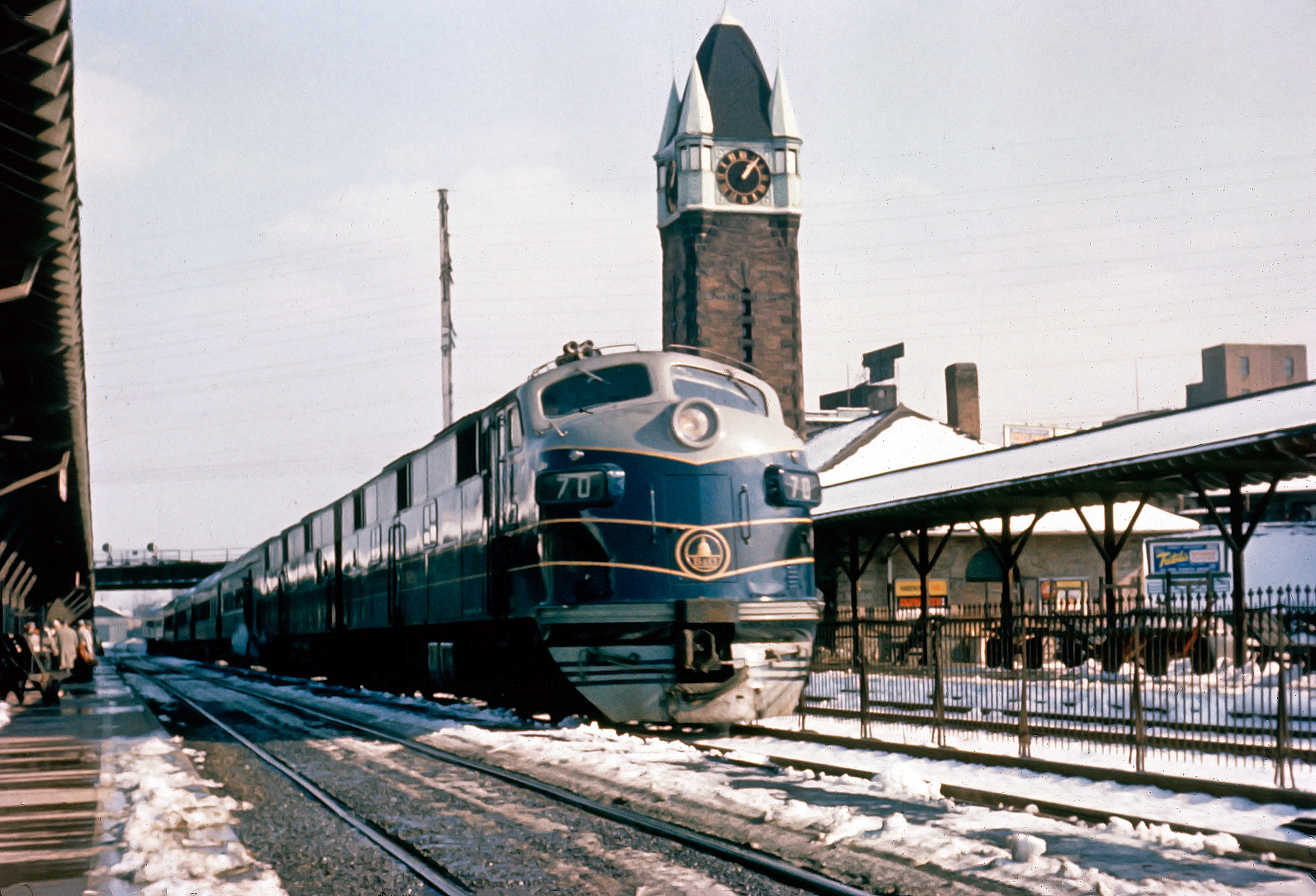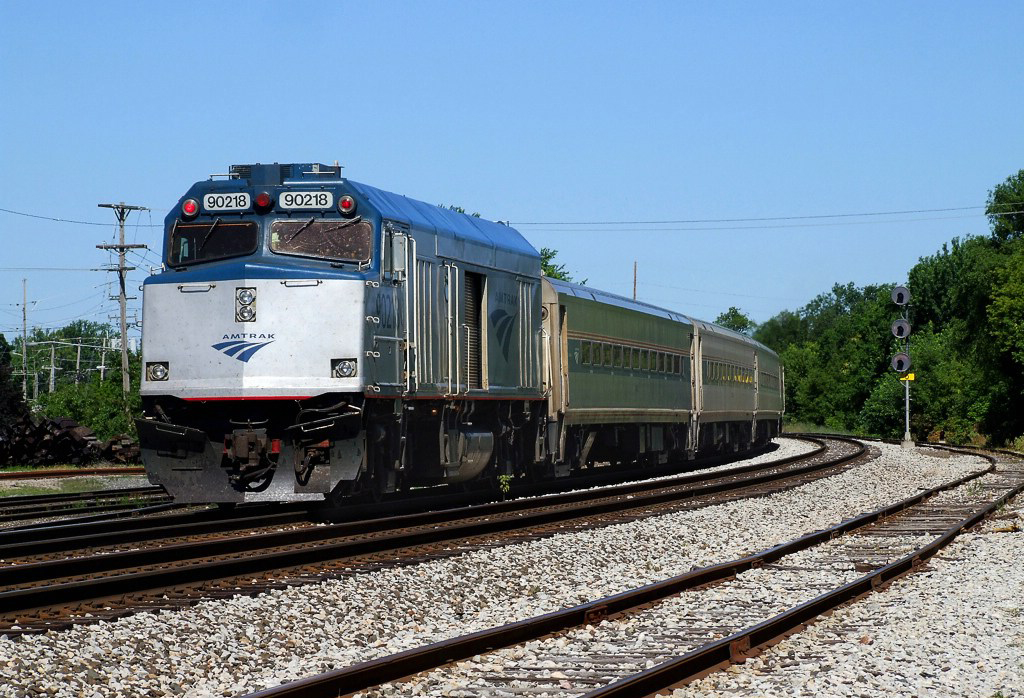GE "C40-9" and "C40-9W" Locomotives: Specs, Roster, History
Last revised: January 1, 2025
By: Adam Burns
The C40-9 and C40-9W was, in many ways, a C44-9W built specifically for Norfolk Southern from January, 1995 through December, 2004. While initial C40-9 was de-rated to 4,000 horsepower, the later C40-9W's could actually be uprated to 4,400 horsepower simply by flicking a switch.
Interestingly, per NS's wishes its first order, a group of 125 locomotives (C40-9), were equipped with GE's Standard Cab. It was the final model to feature this design as wide cabs became standard on all new models after 1995.
Overview
The "Dash 9" series followed the previous "Dash 8s" in the mid-1990s with upgraded electronics and other components, and NS would come to own more than 1,200 examples of the C40-9 and C40-9W.
They served the railroad well for nearly 20 years. While most remain on the active roster the fleet has since entered a rebuild program.
Working in conjunction with General Electric, NS began upgrading its C40-9's in 2015 to 4,400 horsepower and a North American Safety Cab, thus giving them a C44-9W rating.
They also began testing a DC to AC conversion that year beginning with #8879. As part of the overhaul it received a GE wide nose/cab and locomotive speed limiter (LSL), as well as cab signals. It was reclassified as a AC44C6M.
Photos
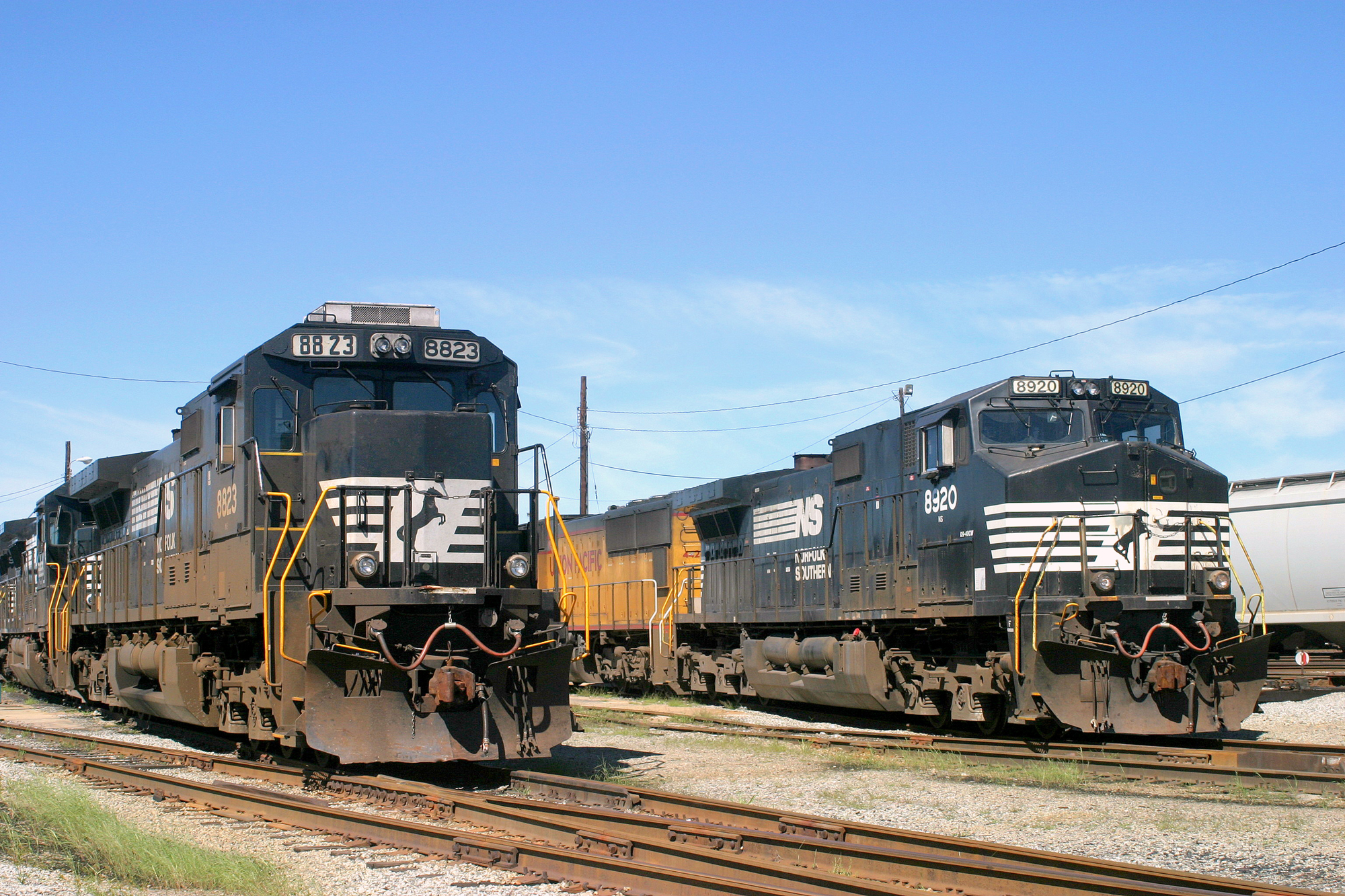 This photo of Norfolk Southern C40-9 #8823 and C40-9W #8920 at Greensboro, North Carolina on September 19, 2004 provides a nice side-by-side comparison of the two variants. Warren Calloway photo.
This photo of Norfolk Southern C40-9 #8823 and C40-9W #8920 at Greensboro, North Carolina on September 19, 2004 provides a nice side-by-side comparison of the two variants. Warren Calloway photo.Refinements
The C40-9 and C40-9W were actually constructed more than a year after the C44-9W debuted (November, 1993) with the first rolling out of Erie in January, 1995.
Brian Solomon notes in his book, "GE Locomotives," the Dash 9 line was more of a marketing tool rather a complete redesign.
It largely continued refinements that began with the Dash 8 series. The notable improvements included:
- Electronic Fuel Injection (Also known as EFI, this system both reduces fuel use and emissions. Both were big selling points in the 1990s, in part due to stricter government regulations.)
- Split Cooling (This describes a system that uses two water circuits to more quickly cool engine intercoolers, which decreases air-intake temperatures and helps further reduce emissions. It also reduces fuel costs and extends engine life.)
- HiAd Truck (The HiAd, or high adhesion, truck first appeared in the Dash 9 series. It is a bolsterless design which allows the wheels to freely pivot and reduces weight transfer. In doing so there is less wear to the wheels and track, thus reducing maintenance costs. It also allows for greater adhesion, as noted in the title.)
- Reduction From 3 To 2 Blowers (GE redesigned the blowers to have a single large blower serve the traction motors instead of two, which reduced maintenance costs.)
One of the design's notable selling points was its incredible traction; 140,000 pounds of starting effort and 109,000 pounds of continuous effort (at 18.3 mph).
Production of the locomotive began in early 1995 and all the original C40-9's, a total of 125 units, were purchased solely by Norfolk Southern.
Very happy with this first batch, and desperately needing power to meet traffic demands of the economic boom ongoing at the time, NS returned for more and began purchasing the C40-9W.
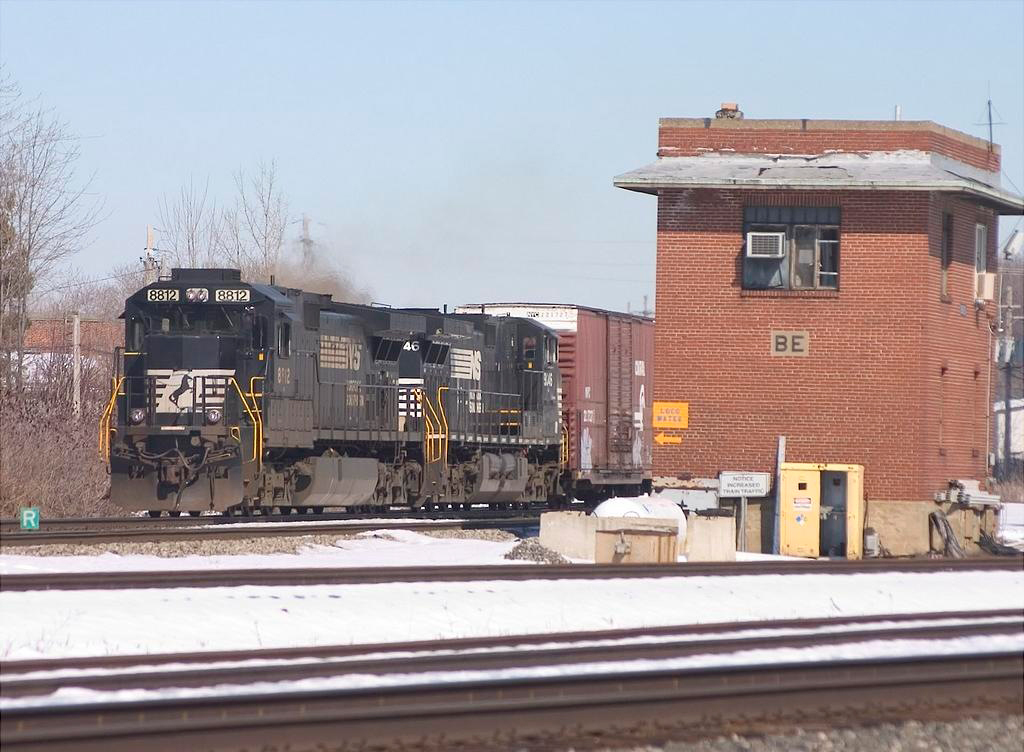 Norfolk Southern C40-9 #8812 has departed Rockport Yard with train 133 as it rolls past BE Tower at Berea, Ohio on March 5, 2005. Wade Massie photo.
Norfolk Southern C40-9 #8812 has departed Rockport Yard with train 133 as it rolls past BE Tower at Berea, Ohio on March 5, 2005. Wade Massie photo.This wide cab variant was identical to its counterpart except for its North American Safety Cab, then standard on all new GE models.
Norfolk Southern never acquired the C44-9W. Its reasoning was sound and based solely on operational needs. As Mr. Solomon's book notes the railroad felt a 4,000 horsepower road-switcher was sufficient to handle the required tonnage.
As such, purchasing a model with greater horsepower, which requires more fuel, would be a waste of operational resources. Interestingly, the C40-9W's could actually achieve 4,400 horsepower.
Data Sheet
| Entered Production | 1/1995 (Norfolk Southern #8764) |
| Years Produced | 1/1995 - 12/2004 |
| GE Class | C40-9, C40-9W |
| Engine | 7FDL16 (16 cylinder) |
| Engine Builder | General Electric |
| Horsepower | 4000-4400 |
| RPM | 1050 |
| Length | 73' 2" |
| Height (Top Of Rail To Top Of Cab) | 15' 4 1/2" |
| Width | 9' 11" |
| Weight | 410,000 Lbs |
| Fuel Capacity | 4,600 Gallons |
| Air Compressor | 3CDC (Westinghouse) |
| Air Brake Schedule | 26L (Westinghouse) |
| Trucks | C-C |
| Truck Type | Hi-Ad Bolsterless |
| Truck Wheelbase | 13' 7" |
| Wheel Size | 40" |
| Traction Motors | 752AH (6), GE |
| Traction Alternator | GMG197, GE |
| Auxiliary Generator | GY27, GE |
| MU (Multiple-Unit) | Yes |
| Dynamic Brakes | Yes |
| Gear Ratio | 83:20 |
| Tractive Effort/Starting | 140,000 Lbs |
| Tractive Effort/Continuous | 109,000 Lbs at 18.3 mph |
| Top Speed | 70 mph |
Production Rosters
C40-9
(Total Built = 125)
| Owner | Road Number | Serial Number | Order Number | Completion Date | Quantity |
|---|---|---|---|---|---|
| Norfolk Southern | 8764-8888 | 48224-48348 | 1930 | 1/1995-4/1995 | 125 |
C40-9W
(Total Built = 1,090)
| Owner | Road Number | Serial Number | Order Number | Completion Date | Quantity |
|---|---|---|---|---|---|
| Norfolk Southern | 8889-9008 | 49065-49184 | 1868 | 1/1996-5/1996 | 120 |
| Norfolk Southern | 9010-9128 | 49669-49787 | 1871 | 2/1997-6/1997 | 119 |
| Norfolk Southern | 9009 | 49938 | 1871 | 2/1997 | 1 |
| Norfolk Southern | 9129-9244 | 50382-50497 | 1884 | 2/1998-6/1998 | 116 |
| Norfolk Southern | 9245-9309 | 51120-51184 | - | 12/1998-5/1999 | 65 |
| Norfolk Southern | 9310-9394 | 51185-51269 | 1903 | 12/1998-5/1999 | 85 |
| Norfolk Southern | 9395-9534 | 52304-52443 | 1919 | 1/2000-5/2000 | 140 |
| Norfolk Southern | 9535-9559 | 52857-52881 | 1931 | 11/2000-12/2000 | 25 |
| Norfolk Southern | 9560-9694 | 52882-53016 | 1934 | 12/2000-4/2001 | 135 |
| Norfolk Southern | 9912-9916 | 53358-53362 | 1972 | 10/2004 | 5 |
| Norfolk Southern | 9695-9744 | 53400-53449 | 1941 | 11/2001-12/2001 | 50 |
| Norfolk Southern | 9745-9811 | 54004-54070 | 1956 | 1/2003-3/2003 | 67 |
| Norfolk Southern | 9812-9886 | 54970-55044 | 1972 | 2/2004-5/2004 | 75 |
| Norfolk Southern | 9887-9911 | 55045-55069 | 1972 | 8/2004-10/2004 | 25 |
| Norfolk Southern | 9917-9978 | 55363-55424 | 1972 | 10/2004-12/2004 | 62 |
Sources
- Foster, Gerald. A Field Guide To Trains. New York: Houghton Mifflin, 1996.
- McDonnell, Greg. Locomotives: The Modern Diesel & Electric Reference, 2nd Edition. Buffalo: Boston Mills Press/Firefly Books, 2015.
- Solomon, Brian. American Diesel Locomotive, The. Osceola: MBI Publishing, 2000.
- Solomon, Brian. GE and EMD Locomotives: The Illustrated History. Minneapolis: Voyageur Press, 2014.
- Solomon, Brian. GE Locomotives: 110 Years Of General Electric Motive Power. St. Paul: MBI Publishing, 2003.
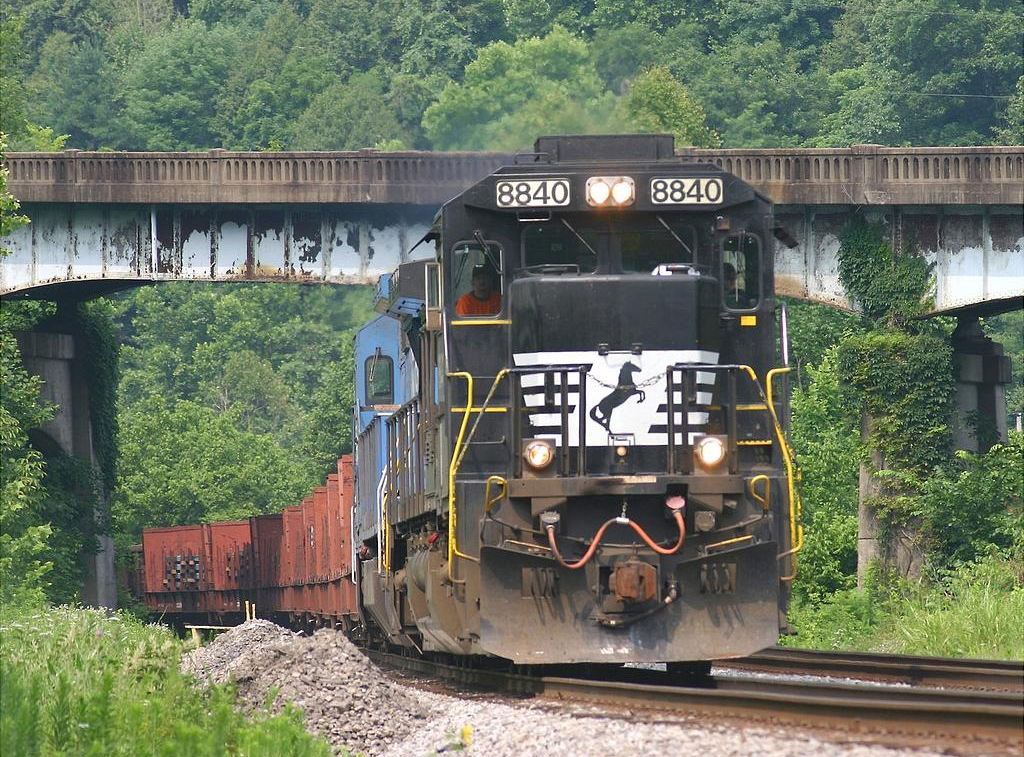 Norfolk Southern C40-9 #8840 leads a westbound freight east of Maher, West Virginia on June 29, 2004. Wade Massie photo.
Norfolk Southern C40-9 #8840 leads a westbound freight east of Maher, West Virginia on June 29, 2004. Wade Massie photo.They were equipped with a Engine Governing Unit, or EGU, that could toggle the horsepower setting between 4,000 and 4,400. Norfolk Southern continued to buy the later Evolution Series with 4,000 horsepower, known as ES40DCs.
By the time GE closed out the C40-9W order, Norfolk Southern owned nearly 1,100 units, and more than 1,200 in all. Up until that time it was one of the largest single orders ever for a particular model by an individual railroad.
Currently, NS has slowed its purchase of new locomotives. Instead, the Class I has focused on an extensive rebuild program of older models to extend their service lives and save money on new purchases.
Recent Articles
-
Guide To Amtrak/Passenger Trains In New Jersey
Apr 10, 25 09:40 PM
This guide highlights passenger train services currently available throughout the state of New Jersey. -
Rio Grande 4-6-6-4 Locomotives: Specs, Roster, Photos
Apr 10, 25 12:47 PM
The Rio Grande owned some large wheel arrangements, including the 4-6-6-4s. Interestingly, the railroad was never satisfied with these engines. -
Guide To Amtrak/Passenger Trains In Michigan
Apr 10, 25 12:06 PM
Michigan offers a variety of passenger train services, allowing travelers to discover the state's beauty and charm in a relaxed and comfortable manner. Learn more here.
